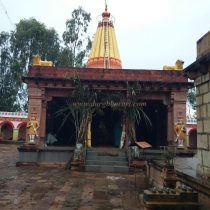GHODGERI
TYPE : GROUND FORT
DISTRICT : BELGAON
GRADE : EASY
Most of us must have seen Bharat Jadhav's film Yedyanchi Jatra, which is on the theme of an open defecation free village. In this film with a fringe of humor, the protagonist's farm land is used as a toilet by two groups in the village and the protagonist's struggle to get them to use the public toilet is shown in the film. We also watch this movie as entertainment for two hours and leave the subject there. We don't even think that something like this is actually happening. But these incidents still happen in the society and we experienced this while visiting the fort in Belgaum district at Ghodgeri fort in Hukkeri taluka. A wall has been constructed in the middle of the fort, and one part has been made into a male toilet and the other part has been made into a female toilet. The village made a fool out of the “Hagandarimukt Gaon” (open defecation free village) scheme of the government.
...
Due to sudden rains in the month of October, we stayed the night at Lingeshwar temple in the village and went to see the fort at 7 am. Even though the experiences at this time are like a comedy film, the heart of trekker cannot help but feel sad after seeing the state of this fort. This fort is located in Ghodgeri village, 28 km above Sankeshwar and 13 km from Hukkeri taluka. This square-shaped fort is situated on one end of the village by the river Ghataprabha and is spread over about one and a half acres. Due to the flood of river Ghataprabha, the riverside ramparts of the fort were destroyed and the remaining three sided ramparts are still in good condition. This fort has four bastions at the four ends and the western ramparts has one more bastion in the middle, so a total of five bastions are present in this fort. The height of the ramparts is 20 feet and the height of the bastion at the ends is 5 feet more than the ramparts i.e. approx. 25 feet. The bastion in the center of the ramparts is, however, the same height as the ramparts itself. Holes are built throughout the ramparts and bastions for firing guns and cannons. The entire ramparts of the fort is built of stone and no mixture like bricks are used for the construction. There is a small temple on the western side of the fort, adjacent to the ramparts. The riverside gate of the fort is completely destroyed today and two circular stone troughs for drinking water for horses can be seen by the riverside. The second gate of the fort had a female toilet, so entry was restricted. Entered the second area but came out in a few moments due to night rain and morning time. This part of the fort is heavily overgrown and there is a sunken well here. As there is a settlement adjacent to the fort's ramparts, one should take a small child from the settlement with themselves since they know a lot about the routes and walk around the ramparts. Language is not a problem as most of the people in the village speak Marathi. After reading all this, the question arises in our mind that should we go here? The answer is only one. When you say there is a fort, you must go there. A solution to this can be found that during rainy season and other times, one can dare and visit the fort except the morning time. What's wrong with trying? While visiting the fort, the medieval Lingeshwar Temple in the village is a must-see. This is the state of the fort when we saw it in the month of October 2019. The history of the fort is unknown today just like the fort itself. It is recorded that Bhawanrao Lokhande, the brother of Maharaj Fattesing Bhosale of Akkalkot, was in charge of this area and he built this fort.
© Suresh Nimbalkar









